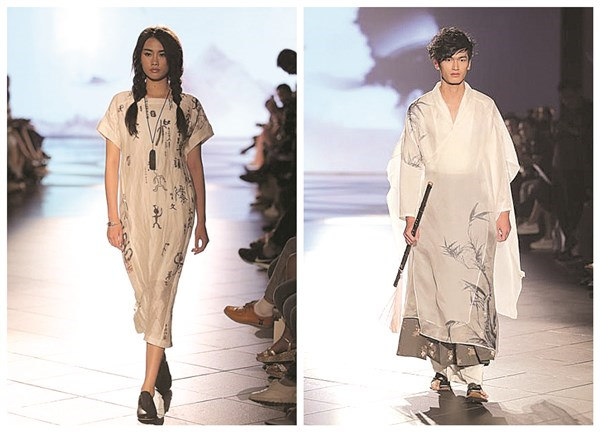
A fashion show held in Suzhou Museum displays the museum collaboration with chic brands on ecommerce platform Tmall.com. Calligraphy and landscape paintings were designed into modern chic.(Photo provided to China Daily)
The free trade zone is being used to link design companies, designers and overseas markets with museums.
Hu says the market of the future consists largely of those born after the 1990s, which explains why the designs on many museum products have a decidedly offbeat edge, veering to the style of Japanese animé, such as items with prints of emperors in scissor-hand poses or with chubby imperial bodyguards.
"We are also keen for our museum products to attract people overseas," Hu says.
In China there are about 4,500 museums, and last year more and more of them jumped on the bandwagon to develop museum products, with the enthusiastic encouragement of the central government as it promotes free-market ideals.
Freedom to innovate
In March, regulatory shackles that had kept state-owned museums from engaging in commercial activities were removed, and they are now encouraged to work with the tourism and cultural and design industries to make and sell artistic items. A plethora of State Council and Ministry of Culture regulations have been promulgated this year to give support to this push, and cultural institutions have been swift in taking advantage of them.
In June a series of animations exquisitely painted in a traditional style made a big splash on social network platforms. What is so eye-catching about them is that they depict emperors' concubines who are switched onto the 21st century. In one short animation, a concubine wears a virtual reality headset to chat with the emperor, in another she chats with friends through social networking, and in another she idly plays games on a smartphone. The animation series with a punch had the full blessing of the Palace Museum in Beijing, and private business was brought into the act, too, the internet giant Tencent putting out a call for young people to design emoticons and games based on the Palace Museum's treasures.
Before this collaboration with Tencent the museum had built up a reputation for itself in developing funny and attractive museum products and apps based on its collection.
The designer Fang Yimin, who has designed jewelry for the Palace Museum, says it is not as though the young do not appreciate traditional culture and museums. However, the institutions need to intrigue them in a way that will be readily acceptable to them, she says. The Palace Museum sets an example in appealing to the young in terms of both products and promotions, Fang says.
Promoting love for culture
For Su Yi, deputy director of the information department of the museum, its efforts to promote the design of games and emoji transcend financial considerations; the museum is keen to promote a love of traditional culture among the young, she says.
The museum developed more than 8,000 products involving clothes, bags, porcelain, paintings, accessories and jewelry. Revenue from its products sold online and in stores exceeded 1 billion yuan ($150 million) last year.
The museum put a mobile phone holder on sale last year, and within an hour of it going on the market about 1,500 had been sold. Apart from merchandise, the museum is also becoming involved in producing films, animations and literature.
Ye Chen, 28, who works for a bank in Shanghai, and who is a self-avowed aficionado of cultural merchandise, says that anything she has bought from the Palace Museum's online shop is creative and attractive. Many of her friends and colleagues follow her to buy them after seeing her purchases.
"I don't like tourist products that simply have a picture from a museum's collection on them or that are poorly done reproductions. I want something that doesn't just appeal to the eye but is useful, too."
What she has bought from national-level museums has been reasonably priced, but the merchandise many other museums sell is overpriced, she says.
Yu Renguo, founder of Dream Castle Culture Company of Beijing, which designed the red fox Ali for Prince Kung's Palace Museum, says: "China is becoming a lucrative market for cultural and creative products. Many foreign companies are also interested in it."
This year he was invited to give a speech on the subject in Las Vegas and Seou, he says.
When he set up his company seven years ago it was difficult to sell cultural and creative products, but with the growing middle class and the young generation, the demand for high-quality museum products has soared, he says.
His collaboration with Prince Kung's Palace Museum in creating Ali was a first for his company, he says, and he is confident work with other museums is in the pipeline.
"Yes, people are excited about the industry, but we still need to make a greater effort in developing products, ones that cover a wide range of areas and that are truly unique. We should not limit ourselves to fridge magnets, scarves, bookmarks and cups."


















































